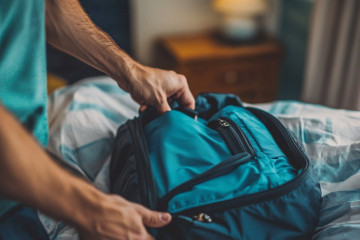Be safe at the beach this summer with these tips.
Summertime is all about beach days. The sand, sunshine, and surf are a trifecta of summertime fun. A beach day is one of the best ways to spend a summer day, but just like with most activities, safety comes first. Here are 12 important safety tips to keep you safe in and out of the water during your next beach day this summer or any time of the year.
1. Always swim in a lifeguarded area
A hot summer day may inspire you to cool off in the water, but whether you are swimming laps or taking a quick dip, always swim in a lifeguarded area so lifeguards can keep an eye out in case you run into any trouble. That way, you will be within an area where assistance can get to you quickly.
2. Avoid sunburn
It may not seem like a beach safety tip, but the quickest way to ruin a beach day is by getting a sunburn. Always wear a solid layer of sunblock and if needed, seek shade under beach canopies and umbrellas. Throw on a hat and layer up with cover-ups as well if you want an added layer of protection. If you get a sunburn, take a cool shower and apply a cold compress at the end of the day. You may also want to apply aloe vera gel or another moisturizer. For an extra touch of relief, place aloe vera gel or lotion in the fridge before applying.
3. Be able to identify rip tides
Rip tides are a type of current where tidal water moves quickly under the surface of the water. They create a current that flows away from the beach. If you get caught in a rip current, it is important to swim parallel back to shore instead of in a straight line.
4. Be aware of hazards and weather conditions
During a beach day, always be aware of water and weather conditions and heed any warnings. According to the American Red Cross, being water competent in the ocean requires different and stronger skills than in a pool. Whenever you are at the beach, ocean, or other open water environments, prepare and watch for changing tides, drop-offs that unexpectedly change water depth, fast-moving currents, riptides, and waves even in shallow water. Other things to look out for include hazards such as debris, rocks, and underwater obstacles; marine life like animals, fish, and vegetation, as well as water activities such as boating, thunder, and lightning. And don’t forget to be cognizant of unexpected changes in air or water temperature.
5. Enter the water cautiously
When entering the water, always enter the water feet first for safety. If entering shallow or unknown waters, go in with extra caution. Do not enter the water from a height, such as a boat or bridge. Only dive in water clearly marked as safe for diving, at least 9 feet deep with no underwater obstacles, and never dive head first into the surf. Also, be careful when standing to prevent being knocked over by currents or waves.
6. Find and follow all beach rules
At the beach, it is important to first find and follow all posted safety rules. There may also be lifeguards or other beach patrol officers on duty who may make announcements over a loudspeaker, or you can ask them about beach conditions too. Follow their guidance and instructions. This applies to when you are on the sand or in the water. They are there to help keep your family safe and ensure everyone has a good time.
7. Keep within your fitness and swimming capabilities
It may be fun to challenge yourself with a fun beach day water activity, game, or swim, but always ensure you keep within your fitness and swimming capabilities. Avoid putting yourself in a situation that may be harmful to your health or unsafe. Lifeguards are there to help you if needed, but stay out of harm’s way by using your better judgment altogether to avoid a potential water rescue.
8. Know beach flag colors and their meanings
When headed to the beach, make sure you and everyone you are with know the beach flag color meanings. Each beach may be different, especially in another country, so if you are unsure, ask a lifeguard, but generally, red means hazardous conditions, where no swimming is allowed, yellow means medium or moderate hazards, and green means calm conditions and low hazards.
9. Know how to swim
This may seem obvious, but ensure every family member learns to swim so they at least achieve water competency skills. That includes being able to enter the water safely, get a breath in, change positioning in the water, stay afloat, and swim a distance to then get out of the water safely.
10. Never swim alone
If you decide to go exploring or swimming in the water, never swim alone regardless of your age or level of swimming skills. Always take a buddy or someone else with you. Plus, everything is better with friends. The more the merrier, right?
11. Stay hydrated
Staying hydrated is important in the hot summer heat and humidity. Temperatures may be high, so even though you may be cooling off in the water, you still need to cool off internally. That means staying hydrated with beverages like water or coconut water and watermelon juice, which are both naturally high in electrolytes and are perfect options if you sweat a lot. Avoid alcohol and caffeine as well, which are both dehydrating.
12. Swim sober and watch others without distractions
Always swim sober. If you are watching others, like children, supervise them sober and without distractions, such as reading or talking on or using a cell phone so you can better keep track of family, friends, and those you are with.



